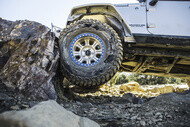Call us
Any questions, suggestions or comments are welcome and will be answered as quickly as possible.
9:30 AM - 6:30 PM (Monday to Saturday)

Learn about Tyre Pressures
Understand Tyre Pressures For Your On & Off-Road Driving Situations
Too much air in the tyre, resulting in premature wear in the center of the tread.
The amount of air inside the tyre pressing outward on each square inch of tyre, which is expressed in pounds per square inch (psi) or kiloPascals (kPa), the metric designation for air pressure. Airtight Synthetic Rubber.
Formulated with virtually impermeable butyl rubber, this material replaces the inner tube in modern, tubeless tyres. Check you air pressure monthly, as some air loss occurs over time.
The amount of air pressure in a tyre, measured in pounds per square inch (psi) before a tyre has built up heat from driving.
The act of putting air into tyres.
The metric unit for air pressure. One psi is equal to 6.9 kPa.
The maximum air pressure to which a cold tyre may be inflated; can be found molded onto the sidewall.
Abbreviation for pounds per square inch, which is the automotive industry's measurement of the pressure in a tyre.
Operating a tyre without sufficient air pressure to support the weight of the vehicle with occupants and additional load; could cause failure of the tyre when heat is generated inside the tyre to the point of degeneration of components.
In regards to off-road Tyre pressures and preserving tyre life, it's key to remember two points below:
To avoid excessive heat build-up caused by over flexing, ensure there is sufficient air pressure in the tyre to carry the load.
In most conditions your vehicle can be driven off-road at the same tyre pressure as on sealed roads. However, in low traction conditions (ie. Sand), it can be beneficial to slightly reduce tyre pressures to achieve better grip. Lowering inflation pressures for improved floatation are only adequate if the tyre maintains sufficient load carrying capacity.
Please note that tyre load, speed and pressures are all interrelated. If you want to reduce your pressure whilst maintaining your load, you must reduce your speed. Reducing your pressure without reducing Load or Speed will lead to excessive heat build-up in the tyre.
Pressures lower than 20psi may be used off-road provided speeds are reduced to 25kph or less, when the tyre has adequate load-carrying capacity.
Always remember to reinflate your tyres to correct pressure immediately upon returning to sealed roads. Failure to reinflate tyres for highway use will seriously affect vehicle handling and possibly result in tyre failure.
*Please note: the technical advice given by us is only a recommendation based on the information provided by you. BFGoodrich is not responsible or liable for any damage due to utilisation based on our technical advice.
The vehicle manufacturer selects the size and type of tyres for their vehicles. They perform the necessary testing to establish the vehicles' optimised operating tyre inflation pressures which can be found on the vehicle placard (located on the inside of the driver's door) and in the vehicle owners' manual. If the tyres on your vehicle are the same size as the original equipment tyre, inflate them to the pressures indicated on the placard.
If the size of the tyres is different than the size indicated on the placard, please contact your closest authorised BFGoodrich dealer for a pressure recommendation.
Any questions, suggestions or comments are welcome and will be answered as quickly as possible.
9:30 AM - 6:30 PM (Monday to Saturday)